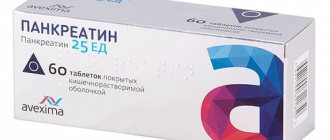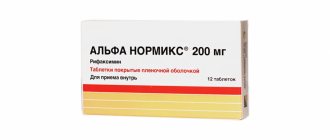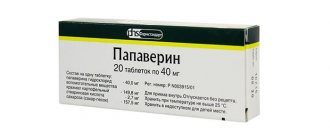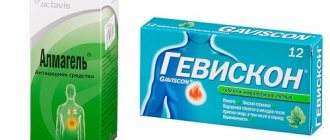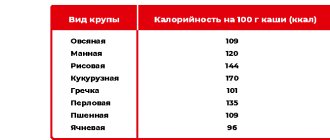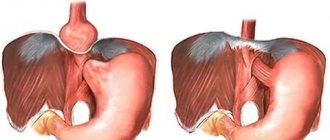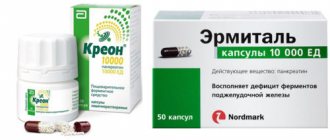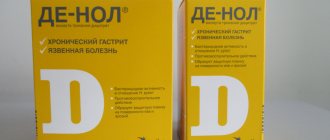Analogs
Level 4 ATC code matches: Gastratcid
Relzer
Maalox
Rennie
Gastal
Venter , Vikalin , Gastrotsepin , Gastal , De-nol.
About the drug
Gaviscon - reduces the acidity of gastric juice.
Sodium alginate and other components of Gaviscon, entering the stomach, interact with the acidic environment inside this organ. As a result of this reaction, a gel with a neutral acid-base balance is formed.
It forms a kind of protective barrier on the irritated surface of the mucous membrane, completely eliminating the negative manifestations of reflux - esophagitis.
This protective film prevents regurgitation - the reflux of acidic contents back into the esophagus due to peristalsis of the stomach muscles.
Even if this process does occur, it is not acidic gastric juice that enters the esophagus, but a gel that does not cause irritation at all. Heartburn, which previously occurred as a result of backflow, does not appear after using Gaviscon. A distinctive feature of Gaviscon is that its action does not reduce the acidity of gastric juice, but protects the mucous membrane from excessive acid exposure through the formation of a gel.
This medicine is a symptomatic remedy. It does not treat diseases that cause heartburn, but relieves the unpleasant symptoms that accompany them. Its mechanism of action is a physical process that does not increase the concentration of drug components in the bloodstream.
Gaviscon Forte price, where to buy
The cost in Russia of Gaviscon Forte ranges from 229 to 269 rubles. per bottle 150 ml. In Moscow, the average price of a suspension is about 236 rubles.
Price in Ukraine for a 150 ml bottle. averages 65 UAH.
- Online pharmacies in RussiaRussia
ZdravCity
- Gaviscon Forte mint oral suspension 150mlReckitt Benckiser Healthcare (UK) Limited
RUB 432 order - Gaviscon Forte mint during pregnancy oral suspension 10ml 12pcs Reckitt Benckiser Healthcare International Ltd
RUR 461 order
Gaviscon
Gaviscon ®
(lat.
Gaviscon
) - antacid* alginate drug.
Anti-regurgitant. Sometimes called gaviscon
.
Gaviscon ® forte
(lat.
Gaviscon forte
) is a drug that differs from Gaviscon in the increased content of the active substance - sodium alginate.
Gaviscon ® Double Action
is a new version of the drug Gaviscon registered in Russia in April 2012. Upon entering the stomach, Gaviscon quickly reacts with its acidic contents, resulting in the formation of an alginate gel that has an almost neutral acidity value (gel pH about 7). The gel forms a protective barrier on the surface of the stomach contents, preventing the occurrence of gastroesophageal reflux. In case of regurgitation or reflux, the gel enters the esophagus, where it has a neutralizing effect on hydrochloric acid and pepsin that enter during reflux and additionally protects the mucous membrane of the esophagus.
Composition of Gaviscon
Gaviscon in Russia is sold in several dosage forms: Gaviscon in the form of a suspension, Gaviscon forte in the form of a suspension (anise or mint), Gaviscon - lemon chewable tablets and Gaviscon - mint chewable tablets.
Gaviscon Double Action - in the form of chewable tablets and suspension for oral administration. Active substances
drug
Gaviscon (suspension)
. 10 ml of oral suspension contains: sodium alginate 500 mg, sodium bicarbonate 267 mg and calcium carbonate 160 mg.
Active substances
drug
Gaviscon forte.
10 ml of oral suspension contains: sodium alginate 1000 mg, potassium bicarbonate 200 mg. (Gaviscon forte, like Gaviscon, contains calcium carbonate, however, unlike Gaviscon, in Gaviscon forte it is classified as an excipient.)
Active ingredients
of chewable tablets
. One Gaviscon tablet contains sodium alginate 250 mg, sodium bicarbonate 133.5 mg and calcium carbonate 80 mg.
Excipients
suspensions of Gaviscon and Gaviscon forte: carbomer, sodium saccharinate, methyl parahydroxybenzoate, propyl parahydroxybenzoate, peppermint oil, sodium hydroxide, purified water. Excipients of Gaviscon tablets: mannitol, macrogol, magnesium stearate, aspartame, copovidone, acesulfame potassium, lemon (or mint) flavor.
Gaviscon Double Action
is available in the form of an oral suspension, packaged in 10 ml sachets and bottles of 150, 200, 300 and 600 ml, as well as in the form of chewable tablets. One chewable tablet contains: sodium alginate 250 mg, sodium bicarbonate 267 mg and calcium carbonate 160 mg. 10 ml of oral suspension contains: sodium alginate 500 mg, sodium bicarbonate 213 mg and calcium carbonate 325 mg.
Application of Gaviscon
Indications for the use of Gaviscon and Gaviscon forte:
symptomatic treatment of dyspepsia associated with increased stomach acidity and gastroesophageal reflux (heartburn, sour belching), a feeling of heaviness in the stomach after eating, including during pregnancy.
The figure on the right (from the work of I.V. Maev et al.) shows the mechanism of action of sodium alginate, the active substance of Gaviscon
.
The main pharmacological and clinical effects of Gaviscon are associated with the presence of alginic acid, which is presented in the drug in the form of sodium alginate. When Gaviscon alginates interact with hydrochloric acid of the gastric juice, the latter is neutralized, a gel is formed that protects the mucous membrane of the esophagus, protecting it from further exposure to hydrochloric acid and pepsin, which manifests itself in a significant reduction in dyspeptic and pain sensations. At the same time, protection against reflux of gastric contents into the esophagus is provided. It is in the formation of a mechanical barrier-raft, which prevents the reflux of stomach contents into the esophagus, that the main mechanism of action of Gaviscon lies. Potassium bicarbonate, which is part of Gaviscon Forte, is a source of carbon dioxide and gives the raft “buoyancy”, while calcium carbonate binds long alginate molecules to each other to strengthen the resulting protective barrier. The antireflux properties of Gaviscon are universal not only in terms of significance and time interval, but also in terms of quality characteristics. By creating a protective barrier on the surface of the gastric contents, Gaviscon is able to significantly and for a long time, more than 4.5 hours, reduce the number of both pathological gastroesophageal refluxes and duodenogastroesophageal refluxes, thereby creating conditions of physiological “rest” for the mucous membrane of the esophagus. It is important that the mechanism of action of Gaviscon is of a physical nature and, thus, it does not have a systemic effect, unlike non-absorbable antacids, which can affect an increase in aluminum levels in plasma and urine when taking aluminum-containing drugs and on stool consistency (Pakhomova I.G. and etc.).
Figure 2 is taken from the article by M.A. Butov. with co-authors.
The key reason for the appearance of pathological gastroesophageal and pharyngolaryngeal refluxes, in which aggressive refluxate from the stomach penetrates into the ENT organs and bronchopulmonary system, is the insufficiency of the antireflux barrier. In this case, the acidity of the gastric contents can be normal or even reduced, that is, the development of the disease is mainly associated with the entry of gastric contents into a non-physiological place for it. In this regard, it is advisable to use alginates, which briefly reduce gastric acidity. The only drug of this group that recently appeared in Russia is Gaviscon (Soldatsky Yu.L.).
| Video: Bakulin I.G. A patient with GERD receives treatment, but it does not help. What to do? |
An acute pharmacological test with Gaviscon carried out at the Central Research Institute of Gastroenterology in 10 patients under the control of pH monitoring demonstrated its antireflux effect lasting from 1.5 to 3.5 hours.
At the same time, the generalized De Meester indicator normalized or decreased significantly. The average acidity of the stomach in 3 patients did not change, in 7 patients there was a moderate antacid effect caused by bicarbonates included in the drug (Bordin D.S., Masharova A.A., Kozhurina T.S.). Directions for use and dosage:
Gaviscon, Gaviscon Forte and Gaviscon double action are taken orally, after each meal and before bedtime:
- Adults and children over 12 years of age take Gaviscon 10-20 ml of suspension. The maximum daily dose is 80 ml.
- Adults and children over 12 years of age take Gaviscon forte 5-10 ml of suspension. The maximum daily dose is 40 ml.
- Children from 6 to 12 years old take Gaviscon 5-10 ml. The maximum daily dose is 40 ml (Instructions for use of Gaviscon and Gaviscon forte suspension).
- Adults and children over 12 years of age take 2-4 tablets of Gaviscon or Gaviscon double action at each dose
- For children under 12 years of age, the dosage regimen for Gaviscon tablets is determined by the doctor (Instructions for use of Gaviscon tablets).
The tablets are chewed thoroughly when taken. Elderly patients do not require dosage changes.
Use of Gaviscon during pregnancy and breastfeeding
Gaviscon is one of the few antacids that can be taken during pregnancy and breastfeeding. This is due to the physical, rather than biochemical nature of its mechanism of action - Gaviscon forms an alginate “barrier-raft” in the stomach, which prevents gastric acid from entering the esophagus, and also to the fact that the main components of Gaviscon are not absorbed into the systemic bloodstream.
Instructions for medical use of Gaviscon
- Instructions for the medical use of the drug Gaviscon (suspension for oral administration [mint]), approved by the Ministry of Health of Russia on March 15, 2017 (pdf, )
- Instructions for medical use of the drug Gaviscon Forte (suspension for oral administration [anise], [mint]), approved by the Ministry of Health of Russia on 04/17/17 (pdf, )
- Instructions for medical use of the drug Gaviscon Double Action (suspension for oral administration [mint]), approved by the Ministry of Health of Russia on August 16, 2016 (pdf, )
- Official information for UK healthcare professionals (English, pdf) "UKPAR Gaviscon Double Action Liquid"
Publications for healthcare professionals regarding the use of Gaviscon in the treatment of the gastrointestinal tract:
- Bordin D.S., Masharova A.A., Kozhurina T.S. Treatment of gastroesophageal reflux disease with alginates // Attending physician. – 2008. – No. 6.
- Bubyakina V.N., Pakhomova I.G., Uspensky Yu.P. Pathogenetic substantiation of the prospects for the clinical use of the alginate-containing drug “Gaviscon” in patients with chronic pancreatitis combined with GERD // Breast Cancer. – 2007. – No. 28. – p. 2171–2176.
- Pakhomova I.G., Tkachenko E.I., Uspensky Yu.P. The first experience in Russia of using Gaviscon in the treatment of gastroesophageal reflux disease // Breast Cancer. – 2007. – volume 15. – No. 22. – p. 1639–1642.
- Soldatsky Yu.L. Otolaryngological manifestations of gastroesophageal reflux disease // Diseases of the digestive organs. – 2007. – Volume 9. – No. 2. – p. 42–47.
- Bury F.D., Dettmar U., Johnston L.M., Lorsch U., Sykes D., Tobel D., Hampson F.C. Suppression of gastroesophageal reflux with alginates. RMJ. Diseases of the digestive system. 2008, volume 10, no. 2, p. 83-86.
- Elohina T.B., Tyutyunnik V.L. Gastroesophageal reflux disease during pregnancy // Breast cancer. – 2008. – volume 16. – No. 19. – p. 1243–1247.
- Vasiliev Yu.V., Yanova O.B., Kozhurina T.S., Bordin D.S. Experience of using Gaviscon in the elimination of gastroesophageal reflux in patients with gastroesophageal reflux disease // Gastroenterology. - 2008. - No. 2. - With. 3-5.
- Shcherbinina M.B., Morozova N.K. Gaviscon forte is a reliable assistant in the treatment of GERD // News of medicine and pharmacy. Gastroenterology (thematic issue). – 2008. – 239.
- Plotnikova E.Yu. Relevance of antacids and alginates for heartburn // iDoctor. Gastroenterology. 2015. 09. pp. 14-18.
- Denisova O.A., Livzan M.A. Possibilities of using the alginate test in the diagnosis of GERD // Experimental and clinical gastroenterology. 2015. Issue 117. No. 5. pp. 67–70.
- Butov M.A., Markova E.V., Faleev V.V. Monotherapy with alginates for patients with gastroesophageal reflux disease // Doctor. 2013. No. 12. pp. 42–46.
- Avdeev V. G. Some issues in the diagnosis and treatment of gastroesophageal reflux disease // Therapeutic archive. – 2015. – 87(10). pp. 120-124.
- Storonova O.A., Trukhmanov A.S., Ivashkin V.T. The effectiveness of an alginate-antacid drug in the treatment of patients with gastroesophageal reflux disease // Russian Journal of Gastroenterology, Hepatology, Coloproctology. 2022. No. 28(5). pp. 46–58.
On the website GastroScan.ru in the “Literature” section there is a subsection “Algitnates”, containing publications addressing the use of Gaviscon.
Video for medical university students
Frame “The mechanism of action of the drug Gaviscon” from a video lecture for 3rd year students of the Faculty of Medicine of PSPbSMU named after. acad. I.P. Pavlova Melnikov K.N. Drugs affecting the gastrointestinal tract
On the website in the “Video” section there is a subsection for patients “Popular Gastroenterology” and subsections “For Doctors” and “For Medical Students and Residents”, containing video recordings of reports, lectures, webinars in various areas of gastroenterology for healthcare professionals and medical students.
general information
In Gaviscon, 10 ml of suspension contains 141 mg (6.2 mmol) of sodium.
This may be important when following a salt-free diet, which may be necessary in cases of congestive heart failure and kidney disease. Contraindications:
age up to 6 years (for Gaviscon), age up to 12 years (for Gaviscon forte), hypersensitivity to the components of the drug.
Side effects:
allergic reactions are possible.
According to the pharmacological index, Gaviscon is classified as an antacid and adsorbent. For ATC - to the group “Alginic acid”, code A02EA01. There is no consensus among doctors as to whether alginates belong to antacids or are an independent group of drugs.
Does not affect the ability to drive a car or operate other mechanisms.
Gaviscon is an over-the-counter product.
Manufacturer:
Reckitt Benckiser Healthcare Limited, UK.
Note: *) some authors do not classify Gaviscon as an antacid, but include it in a separate group of alginates.
Gaviscon has contraindications, side effects and application features; consultation with a specialist is necessary. Back to section
Who is the drug indicated for?
For heartburn, take Gaviscon.
The main indications for the use of Gaviscon are relief of heartburn. Additionally, it prevents problems such as:
- the appearance of dyspepsia;
- sour belching;
- heaviness in the pit of the stomach due to an unhealthy diet or during large periods of
- stages of pregnancy.
If reflux - esophagitis is not corrected by taking antacids, the esophagus in its lower part is damaged due to the irritating effect of stomach acid.
If heartburn occurs regularly, you should not self-medicate, since this symptom can be the cause of serious diseases: impaired tone of the muscle ring that locks the lower esophagus (cardiac sphincter), as well as chronic neurosis.
Severe complications of reflux esophagitis can include narrowing, peptic ulcers, and bleeding.
Heartburn occurs with a hernia of the diaphragmatic esophageal opening, as well as with ulcers and gastritis. Heartburn is caused by obesity, poor diet, and long-lasting symptoms of dyspepsia and flatulence. There is a tendency for heartburn to occur when eating foods such as:
- chocolate,
- fatty and fried foods,
- tomatoes,
- citrus,
- alcohol.
Smoking and the use of certain groups of medications lead to the same results: sleeping pills, sedatives, prostaglandins, Eufillin. They lead to relaxation of the sphincter, and, as a result, to heartburn.
How to take an antacid during pregnancy and lactation
Since Gaviscon components are not absorbed into the blood through the walls of the stomach and intestines, its use is not limited to pregnant and lactating women. The dosage for them does not differ from the usual dosage for adults. Before using the product, you should consult your doctor.
Overdose and contraindications
An overdose of the drug may cause allergic reactions.
Contraindications to the use of the drug are individual intolerance to its components, age under 6 years, phenylketonuria - a genetically determined disorder of protein metabolism.
In rare cases, allergic reactions to the components of the drug may occur:
- anaphylactic shock,
- bronchospasm,
- allergic dermatitis, or urticaria.
For cardiovascular failure and kidney pathologies, it is recommended to take the drug in limited quantities, as it contains a large amount of sodium. In these diseases, sodium is harmful because it retains a large amount of fluid in the body.
There are restrictions on the use of Gaviscon for kidney stones and hypercalcemia, since the drug contains a large amount of this element.

